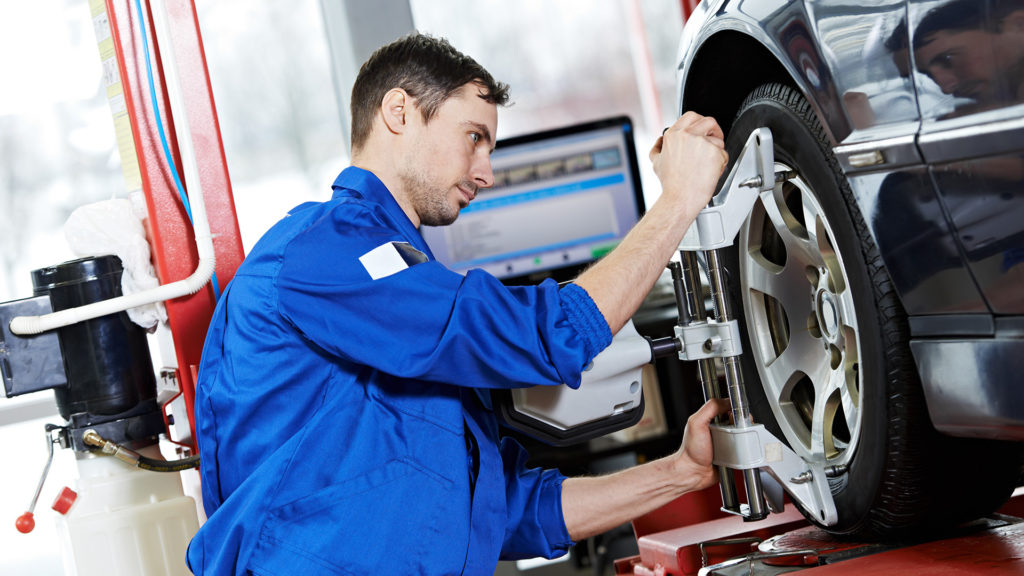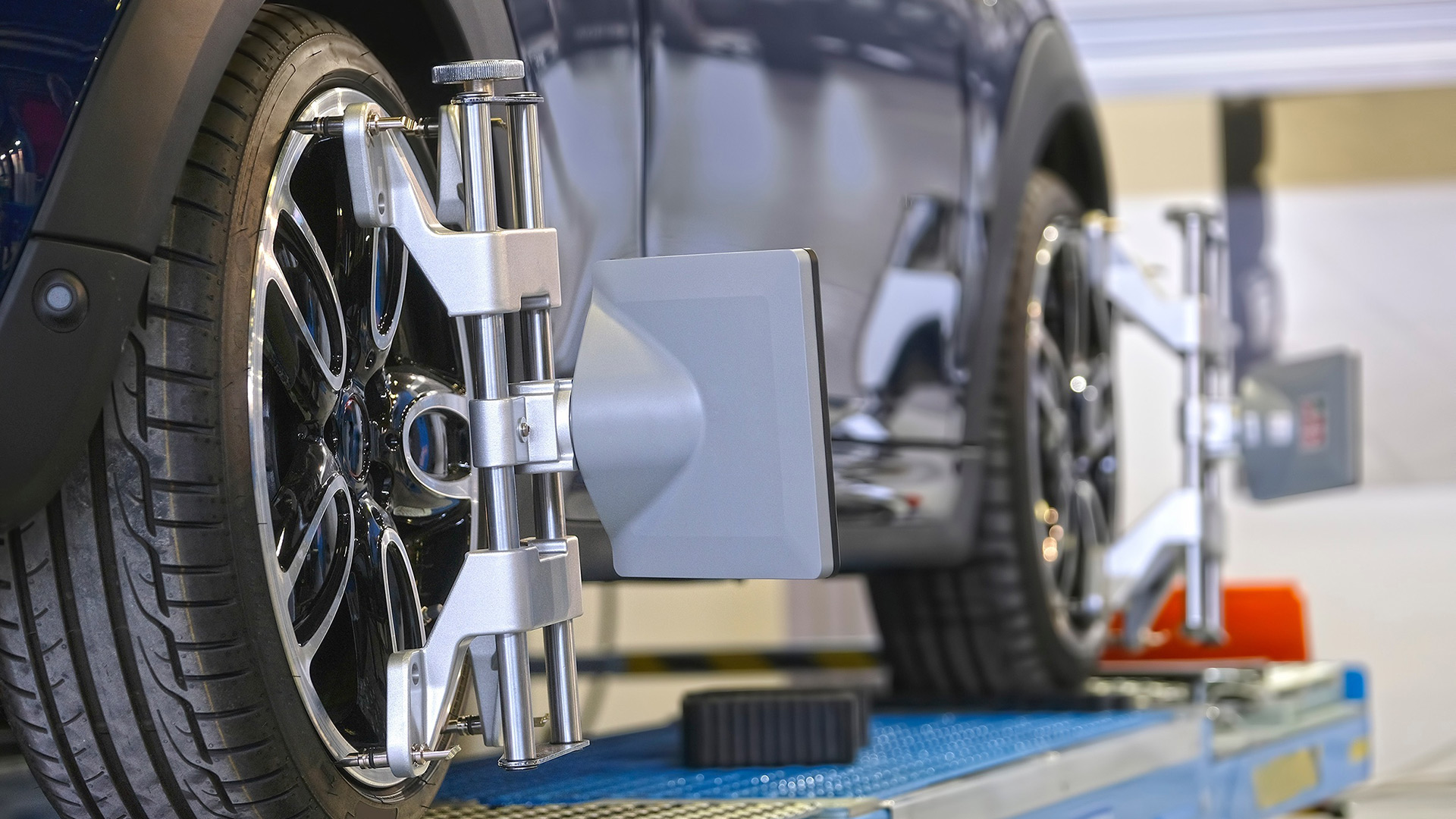There are numerous factors that affect how your car drives, from underinflated or overinflated tires to proper wheel or tire alignment. In this article, we’ll discuss the importance of a wheel or tire alignment and how it affects your tires. We’ll also give you advice on when you should get an alignment, and what to look for to ensure it’s getting done correctly.
A wheel or tire alignment is one of those services that you might get the impression it’s not necessary and the tire shop is simply trying to upsell you on something you don’t need. That’s not always the case, as a wheel or tire alignment is important and shouldn’t be something you ignore entirely. Let’s start with the basics.
A wheel alignment and a tire alignment are the same thing. At most wheel and tire shops, it’ll simply be called an “alignment.” The purpose of an alignment is to adjust the angles of your wheels and tires so they match what the automaker recommends. This is done so that there’s optimal contact between the tires and the road surface.
How do I know if my car needs an alignment?
One of the easiest ways to tell if your vehicle needs an alignment is to let go of the steering wheel while you’re driving and see if the car pulls to one side. Another way to tell is if the steering wheel is off-center when you know you’re driving straight. Other indicators that are less obvious include uneven tire wear, vibrations while driving (although this could be attributed to wheel balance), and poor handling or loose steering.
What is being adjusted during an alignment?
When your vehicle gets an alignment, the technician is adjusting the angles of the wheels relative to each other and the vehicle’s frame. There are three main settings technicians adjust: camber, caster, and toe. All three of these are modified through the vehicle’s suspension. Here’s an explanation for each one.
- Camber: Most car enthusiast have heard of the term camber, which is the inward or outward tilt of the top of the tire when viewed from the front of the vehicle. If the tire tilts inward, it has negative camber. Subsequently, if it tilts outward, that is positive camber. Proper camber will help distribute the load evenly across your tire’s contact patch, which contributes to even wear and better handling.
- Caster: The caster is the angle of the steering axis, the line that passes through the upper and lower ball joints of a wheel’s suspension. If your vehicle has positive caster, then the steering axis tilts toward the rear of the vehicle. That means negative caster is when the steering axis tilts toward the front of the vehicle. This affects your car’s stability, steering effort, and the steering wheel’s ability to return to center.
- Toe: This angle refers to the direction the tires are pointing relative to each other and the vehicle’s centerline, if you were looking from above. If the front edges of your tires are pointing inward, that’s called toe-in. So as you can guess, if they’re pointing outward, that’s called toe-out. Proper toe adjustment helps minimize tire wear and keeps your vehicle straight.

What are the benefits of an alignment?
If your car is properly aligned, you should notice a difference just from driving. But there are many benefits to having your vehicle aligned. For starters, it helps ensure your tires wear evenly, which means extending the life of your tires and ultimately saving you money. A proper alignment will also improve your car’s handling and safety, by providing better traction, stability, and responsiveness. That also means your tires should experience less rolling resistance, which means better fuel economy or driving range if you’re in an EV.
Perhaps more importantly, an alignment will contribute to reduced stress on your car’s suspension components. From ball joints to tie rods and even your shocks, those components can get pretty expensive to replace if they get damaged. Lastly, your vehicle should just feel better to drive once it’s properly aligned.
When should I get an alignment?
Your vehicle’s manual should have a recommended wheel alignment interval. Generally however, we recommend getting an alignment every 12,000 to 15,000 miles or once a year. Another good rule to follow is getting an alignment each time you get new tires put onto your car. No, this isn’t really a sales gimmick by the tire shop to get you to spend more money. It’s a good idea to make sure your brand new tires wear evenly.
Other indicators that you need an alignment is if you notice your tires are wearing unevenly, or your vehicle is pulling to one side — as we mentioned above. That also ties into your steering wheel being off-center. Alignments are also necessary if you’re ever in an accident or collision, even something as minor as hitting a curb. Also, if you replace any of your suspension components, you’ll want to get an alignment.
How much does an alignment cost?
The price for an alignment will vary depending on where you live. That being said, we can give you some general price approximations. A standard two-wheel alignment, which will adjust only your front wheels, should cost anywhere from $50 to $100. Four-wheel alignments are more expensive and should be done if your vehicle is all-wheel drive or has independent rear suspension. Expect it to run from $75 to $150. Alignments can get more expensive — the $150 to $250 range — if you own a luxury vehicle or a sports car. Those types of vehicles tend to have more complicated suspension systems, so special equipment may be necessary to properly do the alignment.
Of course we always recommend calling around for price quotes and checking online for user reviews of local tire and wheel shops. If you find someone you trust and like their service, stick with them!
